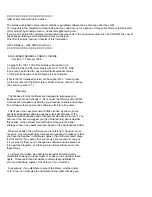
show
reset
start
stop
help
/./system1/-> help name
Unsupported Command
/./system1/-> help enabledstate
Unsupported Command
/./system1/-> help properties
Unsupported Command
/./system1/-> name -h
Invalid command
/./system1/->
•
The
exit
command terminates the CLP session.
•
The
cd
command sets the current default target. The context works similar to a directory path.
The root context for the server and the starting point for a CLP system is /. (forward slash
period). By changing the context, you can shorten commands.
For example:
◦
The
cd
command changes the directory.
◦
The
cd ..
command moves up the tree one directory.
◦
The
cd myfolder
command moves to the
myfolder
folder if
myfolder
is in the
current directory.
•
The
show
command displays values of a property or contents of a collection target. For
example:
/./> show
/.
Targets
system1
map1
Properties
Verbs
cd
version
exit
show
help
The first line of information returned by the
show
command is the current context. In the
example,
/.
is the current context. Following the context is a list of subtargets (Targets) and properties
(Properties) applicable to the current context. The verbs section (Verbs) shows which commands
are available in this context.
The
show
command can also be specified with an explicit or implicit context and a specific
property. An explicit context is
/map1/firmware
and is not dependent on the current context.
An implicit context assumes that the context specified is a child of the current context. If the
current context is /map1, then a
show firmware
command displays the /map1/firmware
data. If a property is not specified, then all properties are shown.
•
The
load
command moves a binary image from a URL to the map. The
load
command is
used to take a binary image from a specific source location (specified as a URL) and place it
at the specified target address. In a remote management processor implementation, the
22
Using LO100
















































